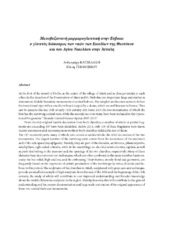Μεσοβυζαντινή μαρμαρογλυπτική στην Εύβοια: ο γλυπτός διάκοσμος των ναών των Εισοδίων της Θεοτόκου και του Αγίου Νικολάου στην Άτταλη
Chapter
Permanent lenke
https://hdl.handle.net/1956/24203Utgivelsesdato
2017Metadata
Vis full innførselSamlinger
Sammendrag
At the foot of the massif of Dirfys, at the center of the village of Attali and in close proximity to each other, lie the churches of the Presentation of Mary and St. Nicholas, two important, large and similar in dimensions Middle Byzantine monuments of central Euboea. The temples’ architecture seems to follow the transitional type with a cruciform based topped by a dome, which are well known in Greece. They can be dated to the late 10th or early 11th century AD. Since 2010 the two monuments, of which the first has the surviving central nave, while the second one is in ruins, have been included in the Operational Programme ‘Thessaly-Central Greece-Epirus 2007-2013.’ From the rich original marble decoration from both churches, a number of whole or partial fragments not exceeding 197 have been identified. Before 2011, only 109 of these fragments were know. Recent restoration and reconstructions works in both churches yielded the rest of them. The 197 recovered parts, many of which join, consist a unified whole, the relief decoration of the two monuments. The largest number of the surviving parts comes from the iconostasis of the sanctuary and of the side apses (παραβήματα). Namely, they are part of the thorakia, architraves, pilasters/jambs, small pillars, eight-sided columns, while in the assemblage we also find semi-columns, capitals, as well as parts that belong to the masonry and the openings of the two churches, respectively. Many of these elements bear decoration in two techniques, which are often combined in the same member harmoniously: the bas-relief, high and low, and the embossing. Their themes, mostly floral and geometric, are frequently found on the repertoire of artistic production of the workshops in Attica, Boeotia and Euboea in this period. The sculptures of the churches in Attali, sculptured with great care and technique, provide an excellent example of high sculpture from the end of the 10th and the beginning of the 11th century, the study of which will contribute to our improved understanding and broader knowledge about the middle Byzantine sculpture in the region. Mainly, however, this will contribute to the general understanding and the proper documentation and large-scale restoration of the original appearance of these two central Euboean monuments.
